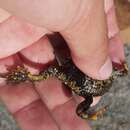Brief Summary
(
Anglèis
)
fornì da IABIN
Diagnosis Small or medium-sized toads, with short, obtuse snout; tympanum concealed; parotoids oval, dorsally located. Glandulous skin and round tibid glands evident
- autor
- Esteban O. Lavilla
- editor
- Diego Arrieta
Distribution
(
Anglèis
)
fornì da IABIN
Endemic to austral forests of Chile (western slopes of the Andes from 39°S to 51°S) and Argentina, from Shangrila (37°S) to 53°S in the Fuegian Archipelago.
- autor
- Esteban O. Lavilla
- editor
- Diego Arrieta
Diagnostic Description
(
Anglèis
)
fornì da IABIN
Adult morphology Snout-vent of about 45 mm or more. Males smaller than females. Head small, flattened, without cephaIic crests; a constriction between head and body. Snout short, rounded and tumefact. Interocular distance equal to upper eyelid and subequal to the eye diameter. Nostrils at equal distance between eye and tip of snout. Tympanum concealed. Tongue subcircular, slightly notched behind, its wideness more than half of the opening of the mouth. Parotoids moderate, oval, dorsally located, on a line towards the center of the neck. Foreleg weak, with slightly developed forearm in males, Hindleg slender; when is adpressed, heel reaches between tympanum and shoulder in males, or the shodder in females. No tarsal fold. Fingers and toes incompletely webbed; rate of the figer lengths: II-I-IV-III. Metacarpal and subarticular tubercles strong; inner metatarsal tubercle developed, outer metatarsal tubercle weak. Skin strongly glandulous, with enlarged longitudinal warts, especially behind the parotoids. Round femoral and tibia1 glands developed. Belly smooth, granular on the posterior abdomen and thighs. Grayish, moderate thumb pads in males, during the breeding season. Color in life: Dark green or chestnut above, with brillant dark glands and three or five longitudinal yellow strip . Hands and feet orange-colored; yellow or orange on the sacral region and thighs; digits white. Belly whitish, marbled with large, bright black spots. Larval morphology Developmental stages 27 through 44 of Gosner (1960). A tadpole in stage 27 has a body length of 7.9 mm, a total length of 18.2 mm and the tail length 10.2 mm. The distance eye-base of tail distance eye-snout ratio is 3.3. A specimen in stage 39 has a body length of 10.2 mm and a total length of 16.0 mm. Body ovoid in lateral view, two times longer than deep. Eyes small (interocular distance 2.3 times the eye diameter), directed anterodorsolaterally. Nostrils evident anterodorsally, pigmented, much closer to eyes than to tip of snout. Spiracle sinistral, short, and lying at about mid-point on body, opening posterolaterally. Anal tube median, short. The caudal musculature i s well developed. Caudal fin rounded at its tip, not extending about the body. Mouth small, anteromedial, labial papillae interrupted anteriorly and posteriorly; tooth rows 2/3. Horny beak black and well developed. Color in life; dark-brown, internal organs not visible. Caudal musculature and fins dark-brown. Color in formalin dark-brown.
- autor
- Esteban O. Lavilla
- editor
- Diego Arrieta

